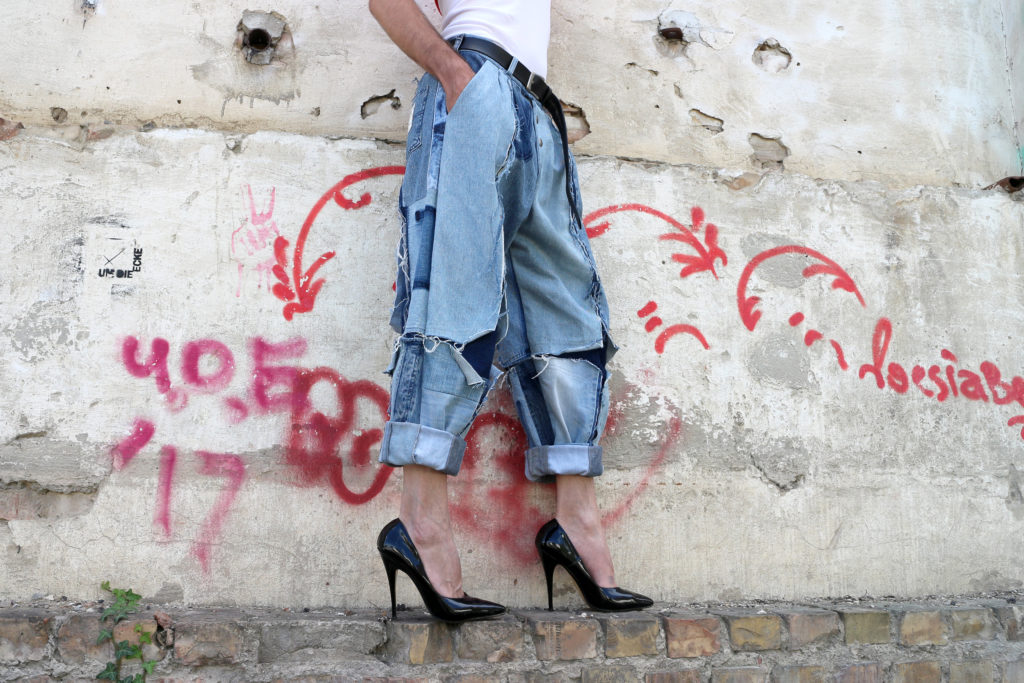- cover: photographer Valeria Di Guardo @valeriadiguardo, stylist @latex_by_betty_le_blanch, model Maya Phoenix @kaye.oz
by Giusy Noce
I met FADE OUT Label thanks to a friend, Yuri, who also accepted to pose for some photos wearing FADE OUT Label outfit . As soon as I saw Andrea’s garments, I sensed a synergy between techniques and ideas that respect a certain lifestyle that many brands say to follow, only not with the same coherent and effective way. Check this interview to learn more, but please be careful to because it may induce compulsive shoopping.
- Can you talk about the beginnings of Fade out Label?
FADE OUT Label was born without a specific plan nor much fuss in Berlin at the beginning of 2015. Nicola Gomiero (who later left the brand) and I (Andrea Bonfini) knew each other first in Rome, we later met again in the German capital and decided to create some clothes for our friends and ourselves. The idea was to create a small collection of ethical fashion, investing very little money but a lot of time. We decided to buy vintage jeans, ripping them off and reassembling them together like pieces of a mosaic. The result was a mini collection of 5 pieces in patchwork denim that immediately aroused great interest “.

Model: Michelle @pecheurdperles
Pic. Nicola Gomiero
MUA @memo_schmage
- Fade out is not a simple re-working label but retools vintage items with contemporary materials and homemade techniques. How and where do you get these items? I thought the way you retooled shopper bags and team scarves was genius
Finding materials to recycle is not difficult, it is difficult to find enough to support the production!
Usually, I can find many of the fabrics I use in charity shops or in vintage markets. At other times, chance or luck comes to my aid. For example, the collection made with vintage shopper bags was born after I made garments for myself, with shopper bags found at home after a move. For the pieces created with the scarves of the vintage soccer teams, instead, we have to thank a friend who sells vintage clothing here in Berlin, and who happened to find a stock of scarves to dispose of.

Model: ÆTHER
Pic. Nicola Gomiero
MUA @memo_schmage
- Screen printing is one of the favorite techniques by underground artists. FOL makes a great use of it as well. How did you approach this technique? Do you find inspiration in the Berlin underground art scene?
Screen printing has always fascinated me, I am a great admirer of Andy Warhol’s works. For FADE OUT LABEL, screen printing was a requirement to print labels and logos of the brand, we wanted to make a 100% handmade product. We asked some friends for help, and we learned the technique from one of the most famous punk squats in Berlin and Europe: Køpi. After that, we kept on experimenting and printing directly in my Atelier. Screen printing was very useful not only for placed graphics but also for printing allover. For example, in the capsule collection Cretino Fosforescente, we printed a soft-colored organic cotton fabric directly through the screen printing frame because we wanted to create a collection inspired by working clothes using organic materials. All the fabrics we found in orange or neon yellow were synthetic, furthermore dyes with fluorescent pigments to the fabric are considered highly polluting. I found the solution in a screen printing shop when I see a selection of natural neon-based water colors.

ph: Federico Reyes @federey
mua: Memo Schmage @memo_schmage
stylist: Sonia Spampinato @thegoldencircus
models: Sê K. Ou, Christina Al Cantara
- In which grade did Berlin inspire your collection
Every creative is influenced by the environment surrounds him. Berlin and it’s underground appearance taught me to give a “dirty and raw” look to the clothes I made. The fashion proposals of FADE OUT LABEL are the result of a cultural mix: The practical approach of the oversize and urban fit is a Berlin style, the design and the attention to detail is instead a typical of Italian fashion.

- How did you get to the definition of unisex clothes and accessory brand?
I never believed in gender boundaries and I have never made a distinction in wearing clothes considered to be for women or men. Differences arise from cultural factors. Many young clothing brands use our same Unisex approach, and like FADE OUT LABEL they photograph clothing worn by boys and girls. I mean, if you’re a man and you like wearing a skirt… why shouldn’t you do it !? If you take a look at the history of fashion and at the clothing used by the various minorities, you realize how gender differences in fashion are nothing but a misconception.

Talent: Yuri 
Jute magazine
Photography @dilani_photography
Styling @aboutparislondon
Styling assistants @avie_avinash & @theninistyling
Hair @alejandromalcolm
MUA @jewelryfortheface
Model Malik
@schonmagazineph @dilani_photography
styling @aboutparislondon
model @pienscheer
hair @alejandromalcolm
mua @jewelryfortheface
styling assistants @avie_avinash + @santoeshatjietaman
- During our first chat, I was impressed by two things you told me: I quote: “With Fade Out Label we always had ‘people’ not ‘models’ to show our clothes … I don’t believe in trendy fashion, so our collections are not suppressed after a season but can always be ordered.” Can you explain the reason for these two decisive choices?
I like to think of FADE OUT LABEL as a “consistent” brand. Our collections do not pursue the aesthetics of trendy and glamour, typical of fast fashion, and are not designed to a single season, but are always available in our catalog because we believe in quality and timeless innovation of what we create. This is the philosophy of our brand and has led us to take photos of our products on “real” people (friends, acquaintances or people we met and impress us for some reason). Having a typical fashion model as our testimonial would have been inconsistent with our philosophy, and in addition, our garments would have seemed disproportionate to bodies that are too thin and too tall. Since the beginning, we have invested time in creating something new, comfortable, designed for everyone, unisex, ethical, attractive but also practical and we have given our customers the opportunity to customize colors and size of their purchase. It was like making a beautiful but also tasty and healthy cake

Fade Out Label 
Talent: Yuri
- What plans do you have in store for the future
This is the most difficult question to be answered. Truth be told, I stopped making long-term plans a few years ago, because I realized that they were creating anxiety and stress so I’m trying to face life as it comes day by day, for example, I don’t believe in business plans, because the creative instinct is stronger). I know that today I am proud of my work and I appreciate my small contribution to the fashion world which is the second most polluting industry in the world.



No Comments